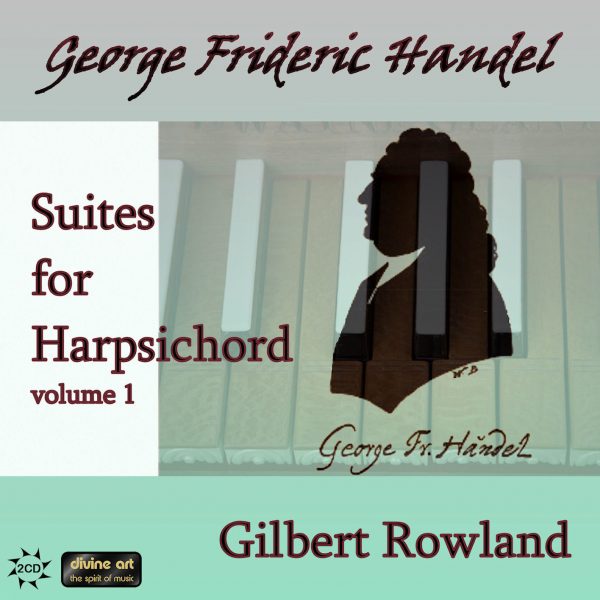The Consort
The two-CD set is the first volume of what will presumably be a series of recordings of the 25 or so keyboard suites for harpsichord by Handel, who published only two collections of such pieces. Firstly in 1720 he published the set of eight so-called Great Suites that are heard and recorded frequently, and a further collection entitled Suite de pieces pour le clavecin was published by Walsh 1733. The nine ‘suites’ contained in this print are a most random selection of works including a Chaconne, and a Prelude and Chaconne. Other suites in the set lack some of the movements associated with the genre: no. 1, for example, consists of a prelude, sonata, aria with variations and a minuet in the relative minor. Further suites were left in manuscript form, probably written for pupils; some of these works are quite substantial, but are heard only rarely.
Recorded at Holy Trinity Church, Weston, Hertfordshire, each of the two CDs reviewed here contains four suites. The first CD opens with the Suite in D minor, the third of the 1720 set. Our attention is grasped right from the start with the demanding virtuoso prelude that utilises the full compass of the keyboard, making much use of arpeggiated figures. The following Allegro fugue is well-ornamented, as are the stylised Allemande and Courante. The extremely ornate embellishments printed in the Aria contrast well with the increasingly virtuosic variations, the concluding Presto being played with much panache, but not so fast that the contrast between the full chords and the two-voice texture is blurred and lost.
This is followed by the Manuscript Suite in A, HWV454, with the standard four movements of allemande, courante, sarabande, and gigue, each movement being Italianate in style. It is probably an early work: the ternary-form sarabande in particular owes much to Italian vocal style, while the gigue recalls Italian string compositions, with its imitations of double stopping, here taken at a brisk but not over-fast pace. The short suite in E minor HWV438, containing only an allemande (which is here played with a subtle application of inégalité), sarabande and gigue, is taken from the 1733 collection; the tempo chosen for the sarabande makes it sound closer to a courante. The brilliant gigue in 24/16 contains its own written-out repeats, and is played at a rapid pace.
The far more substantial Suite in C, HWV443, opens with a präludium which, after some fiery scales and sequential passagework, is followed by a fugue, and the traditional four dances, all played at a leisurely pace which allows Gilbert Rowland to bring out the ‘part’ writing. The suite concludes with an eight-bar chaconne on a standard harmonic progression also used by Pachelbel, with no fewer than 49 variations (although none of them is repeated in this recording). The tempo slows considerably for the highly chromatic variations 36-40 and then picks up again most effectively.
The second CD opens with the suite in G minor HWV439 from the 1733 print, the allemande and courante here given an appropriately improvisatory feel; the sarabande (also found in a revised form in the 1720 collection) is played with great sensuality and the moto perpetuo gigue is performed at a pace sufficient to give the listener the feeling of a tour de force, without being overwhelming. This is followed by the seven-movement suite in G, HWV441, also taken from the 1733 print, which consists of an allemande, an allegro that is basically a variation of the allemande, courante, aria presto, a ritornello menuetto in 3/8 and a lively gavotte with double, both in rondo form, before the suite concludes with the gigue.
The imposing suite in E minor HWV429 follows, taken from the set of 1720, with the opening fugue being taken at a much faster tempo than some performances, but it does just succeed. The remaining four traditional dances are played at a more leisurely tempo that brings out their subdued nature and lush harmonies. The CD closes with a solid performance of the suite in E major HWV430, also from the 1720 set, which concludes with the well-known air and variations known as The Harmonious Blacksmith.
The standard of playing is very high indeed, with some crisp articulation, appropriately added ornamentation in the repeats and a subtly convincing application of inégalité. The generally well-chosen tempi show an understanding of the architecture of each movement. Gilbert Rowland has written some informative notes on each suite and there is a brief biography of his studies and career, but regrettably there is no information about the instrument used. With a considerable variety offered by the pieces included, this is a most enjoyable recording. I look forward to future CDs in the series, so that we can hear more of the lesser-known and rarely recorded suites.
@divineartrecordingsgroup
A First Inversion Company
Registered Office:
176-178 Pontefract Road, Cudworth, Barnsley S72 8BE
+44 1226 596703
Fort Worth, TX 76110
+1.682.233.4978












